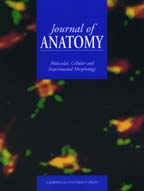Crossref Citations
This article has been cited by the following publications. This list is generated based on data provided by
Crossref.
Ishizeki, K
and
Nawa, T
2000.
Further evidence for secretion of matrix metalloproteinase-1 by Meckel’s chondrocytes during degradation of the extracellular matrix.
Tissue and Cell,
Vol. 32,
Issue. 3,
p.
207.
Gracis, Margherita
Keith, Dennis
and
Vite, Charles H.
2000.
Dental and Craniofacial Findings in Eight Miniature Schnauzer Dogs Affected by Myotonia Congenita: Preliminary Results.
Journal of Veterinary Dentistry,
Vol. 17,
Issue. 3,
p.
119.
Lee, Suk Keun
Kim, Yeon Sook
Oh, Hee Soo
Yang, Kyu Ho
Kim, Eun Cheol
and
Chi, Je Geun
2001.
Prenatal development of the human mandible.
The Anatomical Record,
Vol. 263,
Issue. 3,
p.
314.
Ramaesh, Thaya
and
Bard, Jonathan B. L.
2003.
The growth and morphogenesis of the early mouse mandible: a quantitative analysis.
Journal of Anatomy,
Vol. 203,
Issue. 2,
p.
213.
Yunker, Laurie A.
Undersander, Anne
Lian, Jane B.
Stein, Gary S.
Carlson, Cathy S.
and
Mauro, Laura J.
2004.
The tyrosine phosphatase, OST‐PTP, is expressed in mesenchymal progenitor cells early during skeletogenesis in the mouse.
Journal of Cellular Biochemistry,
Vol. 93,
Issue. 4,
p.
761.
Shimo, Tsuyoshi
Kanyama, Manabu
Wu, Changshan
Sugito, Hiroki
Billings, Paul C.
Abrams, William R.
Rosenbloom, Joel
Iwamoto, Masahiro
Pacifici, Maurizio
and
Koyama, Eiki
2004.
Expression and roles of connective tissue growth factor in Meckel's cartilage development.
Developmental Dynamics,
Vol. 231,
Issue. 1,
p.
136.
Williams, Frank L'Engle
and
Krovitz, Gail E.
2004.
Ontogenetic migration of the mental foramen in Neandertals and modern humans.
Journal of Human Evolution,
Vol. 47,
Issue. 4,
p.
199.
Kim, Hyongbum
Suh, Hwal
Jo, Sangmee Ahn
Kim, Hyun Woo
Lee, Jung Min
Kim, Eun Hae
Reinwald, Yvonne
Park, Sang-Hyug
Min, Byoung-Hyun
and
Jo, Inho
2005.
In vivo bone formation by human marrow stromal cells in biodegradable scaffolds that release dexamethasone and ascorbate-2-phosphate.
Biochemical and Biophysical Research Communications,
Vol. 332,
Issue. 4,
p.
1053.
Li, C.B.
Zhou, G.H.
Xu, X.L.
Huang, M.
and
Li, M.Y.
2005.
The mineral composition and microscopic changes in thoracic buttons of Chinese Yellow steer with age.
Meat Science,
Vol. 69,
Issue. 1,
p.
101.
2005.
Bones and Cartilage.
p.
559.
Firat, Deniz
Kuntsal, Leyla
and
Sirin, Yigit
2005.
Protective Effects of Prenatal Administration of Folic Acid on Retinoic Acid-Induced Cellular Damages of Meckel's Cartilage in Rats.
The Tohoku Journal of Experimental Medicine,
Vol. 205,
Issue. 1,
p.
27.
Sakakura, Yasunori
Tsuruga, Eichi
Irie, Kazuharu
Hosokawa, Yoichiro
Nakamura, Hiroaki
and
Yajima, Toshihiko
2005.
Immunolocalization of receptor activator of nuclear factor‐κB ligand (RANKL) and osteoprotegerin (OPG) in Meckel's cartilage compared with developing endochondral bones in mice.
Journal of Anatomy,
Vol. 207,
Issue. 4,
p.
325.
Lee, Young Joon
Lee, Sang Shin
Park, Byoung Geol
Woo, Sang Doo
Kim, Eun Cheol
Kim, Yeon Sook
Lee, Suk Keun
and
Chi, Je Geun
2006.
Radiological trace of mandibular primary growth center in postnatal human mandibles.
The Anatomical Record Part A: Discoveries in Molecular, Cellular, and Evolutionary Biology,
Vol. 288A,
Issue. 12,
p.
1234.
Nie, X
Luukko, K
and
Kettunen, P
2006.
FGF signalling in craniofacial development and developmental disorders.
Oral Diseases,
Vol. 12,
Issue. 2,
p.
102.
Sakakura, Yasunori
Hosokawa, Yoichiro
Tsuruga, Eichi
Irie, Kazuharu
Nakamura, Masanori
and
Yajima, Toshihiko
2007.
Contributions of matrix metalloproteinases toward Meckel’s cartilage resorption in mice: immunohistochemical studies, including comparisons with developing endochondral bones.
Cell and Tissue Research,
Vol. 328,
Issue. 1,
p.
137.
Barbosa, Ana C.
Funato, Noriko
Chapman, Shelby
McKee, Marc D.
Richardson, James A.
Olson, Eric N.
and
Yanagisawa, Hiromi
2007.
Hand transcription factors cooperatively regulate development of the distal midline mesenchyme.
Developmental Biology,
Vol. 310,
Issue. 1,
p.
154.
Sakakura, Yasunori
Hosokawa, Yoichiro
Tsuruga, Eichi
Irie, Kazuharu
and
Yajima, Toshihiko
2007.
In situ localization of gelatinolytic activity during development and resorption of Meckel's cartilage in mice.
European Journal of Oral Sciences,
Vol. 115,
Issue. 3,
p.
212.
Jaskoll, Tina
Abichaker, George
Sedghizadeh, Parish P
Bringas, Pablo
and
Melnick, Michael
2008.
Cytomegalovirus induces abnormal chondrogenesis and osteogenesis during embryonic mandibular development.
BMC Developmental Biology,
Vol. 8,
Issue. 1,
Sakakura, Yasunori
Shibui, Toru
Irie, Kazuharu
and
Yajima, Toshihiko
2008.
Metabolic mode peculiar to Meckel’s cartilage: immunohistochemical comparisons of hypoxia‐inducible factor‐1α and glucose transporters in developing endochondral bones in mice.
European Journal of Oral Sciences,
Vol. 116,
Issue. 4,
p.
341.
Wyganowska-Świątkowska, Marzena
and
Przystańska, Agnieszka
2011.
The Meckel’s cartilage in human embryonic and early fetal periods.
Anatomical Science International,
Vol. 86,
Issue. 2,
p.
98.




